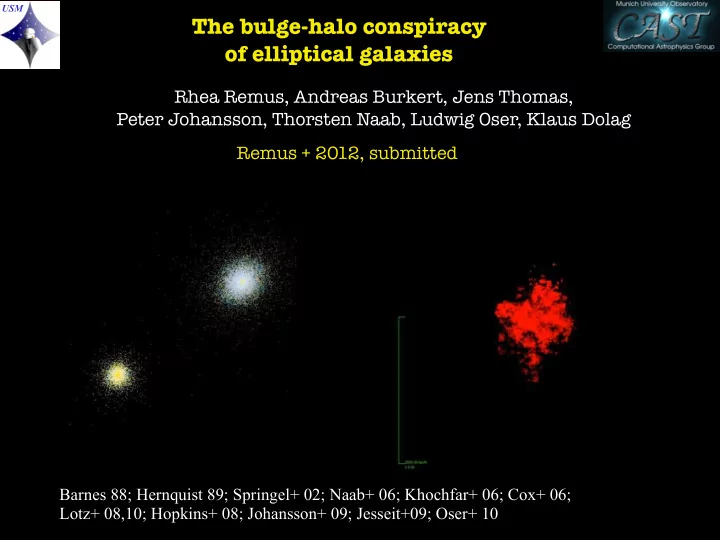

USM The bulge-halo conspiracy of elliptical galaxies Rhea Remus, Andreas Burkert, Jens Thomas, Peter Johansson, Thorsten Naab, Ludwig Oser, Klaus Dolag Remus + 2012, submitted Barnes 88; Hernquist 89; Springel+ 02; Naab+ 06; Khochfar+ 06; Cox+ 06; Lotz+ 08,10; Hopkins+ 08; Johansson+ 09; Jesseit+09; Oser+ 10
Atlas 3D and the stellar structure of ellipticals (Cappellari+11; Emsellem+11; Bois+ 11)
Dark matter in ellipticals: The PN survey (Mendez+ 01; Romanowski+ 03; Dekel+ 05)
SLACS strong lensing survey (Auger+ 10; Barnabe+ 11; Lyskova+ 12) ρ total r − 2
• Schwarzschild models • 10%-50% dark matter within half light radius
Isolated binary mergers (Johansson+ 09)
Isolated binary mergers (Johansson+ 09) • Controlled initial conditions • Observed formation scenario • Realistic progenitor spirals • No cosmological treatment
Cosmological resimulations (Oser+ 10, 11) • More “realistic” (???) initial conditions • Full mass range of ellipticals • No spirals as progenitors 17 central ellipticals, 4 substructure ellipticals
The halo-spheroid conspiracy ρ tot r − 2
The halo-spheroid conspiracy in cosmological simulations
Binary mergers • Close to solution of isotropic Jeans equation • Very close to isothermal Cosmo • Very close to isotermal • Large spread in density slope • Steep slopes show large deviation from isotropic Jeans solution
Binary dark matter stars Cosmo
Stellar dispersion slope versus total density slope • Comparison with Thomas et al. favors multiple merger origin • Steepness of density slope depends critically on central concentration of baryonic component ( see however van Dokkum & Conroy 11,12: Conroy & van Dokkum 12)
Slope evolution and violent relaxation
Slope evolution and violent relaxation
Slope evolution and violent relaxation Massive elliptical: Low-mass elliptical: multiple substantial mergers minor mergers and accretion
Summary • The stellar and dark matter density and velocity dispersion profiles of ellipticals are not power laws. • Their combined profiles can however be well fitted by power-laws in the radius range of 0.1 to 3 reff. • Mergers of 2-component systems lead to combined power-law profiles that are isothermal (violent relaxation???). • Deviations from isothermal profiles therefore contain valuable information about the accretion history of a given galaxy. • Cosmological simulations, despite their known caveats, are in good agreement with recent observations of Coma ellipticals.
Recommend
More recommend